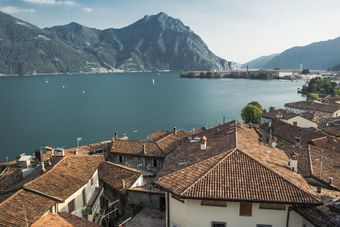Lake Iseo
| Lake Iseo Lago d'Iseo |
|
|---|---|

Lake Iseo from Montisola
|
|
| File:Lake Iseo.png
map
|
|
| Location | Lombardy |
| Coordinates | Lua error in package.lua at line 80: module 'strict' not found. |
| Primary inflows | Oglio |
| Primary outflows | Oglio |
| Catchment area | 1777 km² |
| Basin countries | Italy |
| Max. length | 25 km |
| Surface area | 65.3 km² |
| Average depth | 124 m |
| Max. depth | 251 m |
| Residence time | 4.2 years |
| Surface elevation | 181 m |
| Islands | Monte Isola, Loreto, St. Paul |
| Settlements | see article |
Lake Iseo or Lago d'Iseo [ˈlaːɡo diˈzɛːo] or Sebino [seˈbiːno] is the fourth largest lake in Lombardy, Italy, fed by the Oglio river.
It is in the north of the country in the Val Camonica area, near the cities of Brescia and Bergamo. The lake is almost equally divided between the Provinces of Bergamo and Brescia. Northern Italy is renowned for its heavily industrialised towns and in between there are several stunning lakes. Lake Iseo remains one of outstanding natural beauty, with its lush green mountains surrounding the crystal clear lake.
There are several medieval towns around the lake, the largest being Iseo and Sarnico. These are filled with bars, shops, cafes, hotels, B&B's and several campsites running alongside the lake shore. The Franciacorta wine region, just minutes away from the lake produces some of the worlds finest sparkling wines. The road north to Switzerland used to run along the side of the lake, and stories about entire families being swallowed up by the murky waters abound. A much safer road, carved into the side of the mountains, now exists.
In the middle of the lake is Monte Isola (or Montisola). There is easy access via the regular running lake ferries.
Settlements
Around the shore of the lake are a number of small towns:-
On the Brescian side:
On the Bergamo side:
and on Montisola (Province of Brescia):
Two smaller islands, Loreto and San Paolo, are privately owned.
External links
- Photos and information about Lake Iseo
- Info Monteisola
- Lake Iseo Information
 Media related to Lua error in package.lua at line 80: module 'strict' not found. at Wikimedia Commons
Media related to Lua error in package.lua at line 80: module 'strict' not found. at Wikimedia Commons